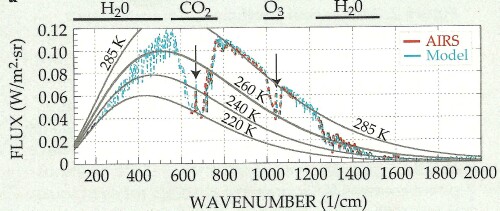Earth Radiation & Global Warming
| The following is adapted from the article Infrared Radiation and Planetary Temperature by Raymond T. Pierrehumbert of the University of Chicago in Physics Today, Jan 2011, p.36. |
This graph shows the radiation from the Earth into space (wavenumber=1/wavelength): 
-
There are two broad wavenumber regions where the presence of water vapor (H2O) reduces the radiation, one at low wavenumber (high wavelength) and one at high wavenumber (low wavelength).
-
There is a central wavenumber region where the presence of CO2 reduces the radiation.
-
There is a narrow wavenumber region where the presence of O3 (ozone) reduces the radiation.
The
absorption of Earth radiation by the greenhouse-gas molecules reduces the Earth's emission of infrared radiation into space by emitting some of the absorbed radiated energy back to the Earth (the greenhouse effect).
(Other global-warming gases than CO2, O3 and H2O are not shown.) |
The blue points are computed global annual-mean values from the physics of infrared absorption by molecules and the red points are satellite measurements. The four curves are Planck radiation for specific surface temperatures with no absorption by molecules in the atmosphere. (K = Kelvin temperature = Celsius temperature + 273.15) The Earth radiation follows the 285-K Planck-radiation curve except for the four regions of absorption by molecules in the atmosphere.
The fact that the theoretical calculation of molecular absorption agrees so well for the upper end of CO2 absorption, O3 absorption and the higher H2O absorption gives confidence in the theoretical calculation for the lower end of CO2 absorption and the lower H2O absorption.
|
| The reduced radiation due to molecular absorption in the atmosphere allows more of the energy of the Sun's radiation to remain on the Earth's surface, thereby increasing the Earth's mean temperature. |
| "For present Earth CO2 conditions, CO2 accounts for about a third of the clear-sky greenhouse effect in the tropics and for a somewhat greater portion in the drier, colder extratropics; the remainder is mostly due to water vapor. The contribution of CO2 to the greenhouse effect, considerable though it is, understates the central role of the gas as a controller of climate. The atmosphere, if CO2 were removed from it, would cool enough that much of the water vapor would rain out. That precipitation, in turn, would cause further cooling and ultimately spiral Earth into a globally glaciated snowball state. It is only the presence of CO2 that keeps the Earth's atmosphere warm enough to contain much water vapor. Conversely, increasing CO2 would warm the atmosphere and ultimately result in greater water-vapor content." |
| "The CO2 greenhouse effect is directly visible in satellite observations of the bite taken out of the IR spectrum near 667 cm-1, a feature whose details agree precisely with results of calculations based on first-principles radiative transfer calculations. Laboratory spectroscopy demonstrates that the width of the bite will increase as CO2 increases, and warming inevitably follows as a consequence of well-established energy-balance principles. The precise magnitude of the resulting warming depends on the fairly well-known amount of amplification by water-vapor feedbacks and on the less-known amount of cloud feedback. There are indeed uncertainties in the magnitude and impact of anthropogenic global warming, but the basic radiative physics of the anthropogenic greenhouse effect is unassailable." |
Global Warming and Increased Precipitation
Global warming increases global precipitation, which includes increased snow during winters. Here are some web pages about global precipitation:
Increased snow in some regions during winter causes colder temperatures for those regions because the snow reflects solar energy back into space.
Of course, in warmer regions near coasts increased precipitation results in floods.
Global warming causes droughts in some regions in the center of large continents because the increased evaporation is moved by weather patterns away from those regions. The location of mountain chains can have a large effect on precipitation patterns over large continents. There can occur periods of droughts and floods in the same regions.
Global Warming and Unstable Climate and Weather Patterns
When the mean Earth temperature is stable for long periods, climate and weather patterns are more steady. When the mean Earth temperature is changing, either decreasing or increasing for long periods, climate and weather patterns can be quite chaotic.
Roper Global warming web pages
L. David Roper, http://www.roperld.com/personal/roperldavid.htm; roperld@vt.edu
6-apr-16
